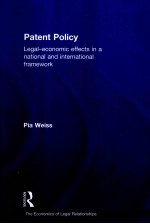

PATENT POLICY LEGAL-ECONOMIC EFFECTS IN A NATIONAL AND INTERNATIONAL FRAMEWORKPDF电子书下载
- 电子书积分:10 积分如何计算积分?
- 作 者:PIA WEISS
- 出 版 社:ROUTLEDGE
- 出版年份:2010
- ISBN:
- 页数:239 页
1 General introduction 5
PART Ⅰ Patent systems and patent law 5
2 Introduction 7
3 A short history of the patent system 8
3.1 A general overview 8
3.1.1 The first patents 9
3.1.2 The guilds in the middle ages 9
3.1.3 The development in the United States 11
3.2 lnternational patent treaties 13
3.2.1 The Paris Convention 13
3.2.2 The TRIPs Agreement 15
3.2.3 The Patent Cooperation Treaty 18
3.A Important development steps of patents 19
4 Foundations of patent systems 22
4.1 Natural rights theory 22
4.1.1 John Locke and the natural rights theory 22
4.1.2 Intellectual property and natural rights 23
4.2 Utilitarian theory 24
4.2.1 Jeremy Bentham and utilitarianism 24
4.2.2 Utilitarianism and patent systems 24
4.2.3 Two patent theories 27
5 An introduction to patent law and policy instruments 30
5.1 Thepatentsystem 31
5.1.1 Patent prosecution 31
5.1.2 Patent enforcement 34
5.2 Legal policy instruments and their economic effects 35
5.2.1 Patent prosecution 35
5.2.2 Patent enforcement 43
5.3 From patent law to economic modelling 46
5.A A comparison of patent fees 48
PART Ⅱ Patent policy from a national perspective 49
6 Introduction 51
7 The optimal patent term 53
7.1 Patent maintenance 54
7.2 Nordhaus’model of optimal unoCorm patent lofe 55
7.2.1 Public vs private knowledge as the source for ideas 55
7.2.2 The timing of the decisions 56
7.2.3 The market stage 57
7.2.4 The inventor’s research effort 58
7.2.5 The optimal patent length 60
7.3 Optimal renewal schemes 63
7.3.1 Asymmetric information on the patent value 63
7.3.2 The benchmark models 64
7.3.3 Optimal differentiation policy 67
7.A Proofs to the lemmata and propositions 72
8 Patent scope 74
8.1 Exogenous patent value 75
8.1.1 The general framework 75
8.1.2 General results 79
8.1.3 The optimal policy design for horizontal product differentiation 82
8.2 Endogenous patent value 86
8.2.1 A patent race with endogenous research effort 87
8.2.2 The optimal investment decision 89
8.2.3 The socially optimal policy design 90
8.3 Patent scope and costly imitation 92
8.3.1 A model with endogenous research effort and costly imitation 92
8.3.2 The firms’decisions 93
8.3.3 The optimal patent length and patent scope when imitation is costly 96
8.A Proofs to the lemmata and propositions 97
9 Patent breadth 100
9.1 A simple model without patent length 101
9.1.1 A sequence of two inventions 101
9.1.2 The optimal patent-anti-trust policy 107
9.2 An infinite sequence of inventions with patent term 112
9.2.1 A sequence of innovations and patent instruments 112
9.2.2 A model of homogeneous tastes 115
9.2.3 Heterogeneous tastes in a model of a natural oligopoly 121
9.A Proofs to the lemmata and propositions 127
10 The non-obviousness standard 128
10.1 The basic framework of a model with an infinite sequence of patent races 129
10.1.1 An infinite sequence of patent races 129
10.1.2 Patentability and the non-obviousness standard 130
10.1.3 Demand and prices 132
10.1.4 The expected profits 132
10.2 Firms and the optimal research effort 133
10.2.1 The ex-post value functions 133
10.2.2 The ex-ante value function 136
10.2.3 The optimal research effort 136
10.3 The optimal non-obviousness standard 140
10.3.1 The ex-post version 140
10.3.2 The ex-ante version 142
10.4 The ease of invention 144
10.A Proofs to the lemmata and propositions 147
PART Ⅲ Patent policy in an international framework 153
11 Introduction 155
12 New patentable subject matters 157
12.1 A simple model of new patentable subject matters 158
12.1.1 Two firms engaged in a single patent race 158
12.1.2 The domestic firm’s disadvantage 159
12.1.3 The home country’s decision 163
12.1.4 Shortcomings 166
12.2 New patentable subject matters and endogenous research effort 166
12.2.1 Basic assumptions 167
12.2.2 The firms’value functions 169
12.2.3 The firms’optimal choice 173
12.2.4 The effect on firms 178
12.2.5 The home country’s welfare functions 180
12.2.6 Welfare considerations 183
12.A Proofs to the lemmata and propositions 183
13 Different non-obviousness standards 188
13.1 The basic framework 188
13.1.1 Patentability and the non-obviousness standard 189
13.1.2 Demand and prices 190
13.1.3 The firms’ position in an ex-post situation 190
13.1.4 The expected profits 191
13.2 Differences in the non-obviousness standard and their effect on firms 193
13.2.1 The value functions 193
13.2.2 The effect of a diverging domestic non-obviousness standard on firms 196
13.3 The optimal non-obviousness standard 198
13.3.1 The general forms of the social welfare functions 198
13.3.2 The society’s unilateral decision 202
13.3.3 Simultaneous decision 205
13.4 Policy implications 206
13.A Proofs to the lemmata and propositions 208
Notes 213
Bibliography 223
Author index 232
- 《如何开金口:让您赚大钱的演说术》ALAN WEISS著;贾士蘅译 1999
- 《数据结构与算法分析 Java 语言描述》(美)Mark Allen Weiss著,冯舜玺译 2009
- 《变质构造岩的构造分析》特纳(F.J.Turner),韦斯(L.E.Weiss)著;周金城等译 1978
- 《怎样开拓美国市场》(美)韦 斯(Weiss,Kenneth D.)著;孙希光等译 1993
- 《孕前准备 孕育宝典》(美)Robin Elise Weiss著;张维娜,孙鹏程译 2006
- 《皇帝的新衣 职场中的讲真话》(美)韦斯(Weiss,L.)著;王毅,王昊译 2006
- 《孕期产后健身》(美)R0bin Elise Weiss著;张晓东译 2006
- 《东南亚酒店 中英文对照版》(泰)卢吉拉珀·PIA.王莉著;冯敏译 2014
- 《跳出想吃又怕胖的陷阱》(美)利莉·韦斯(Lillie Weiss)等著;张大荣译 2002
- 《金球》(德)诺贝特·魏斯(Norbert Weiss)著;方厚升译 2004
